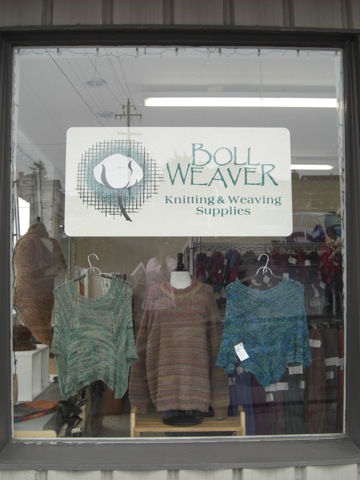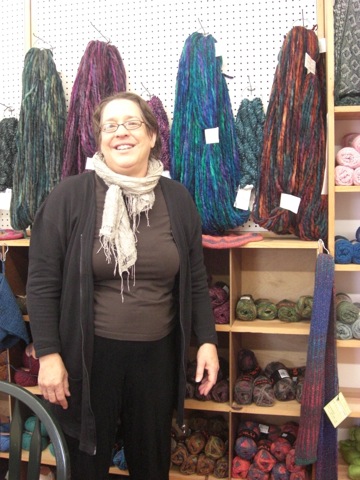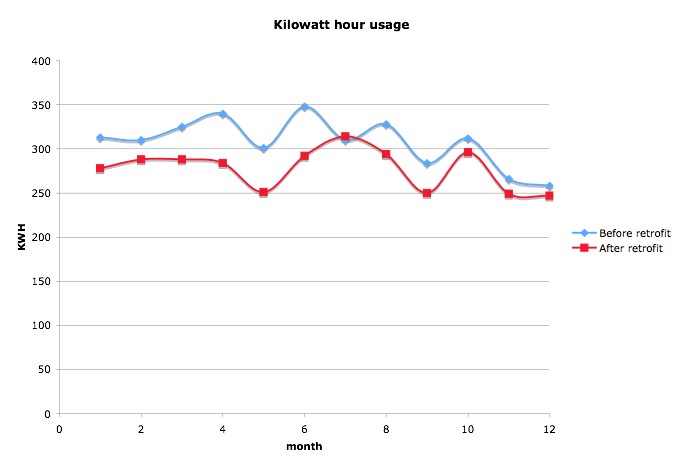
Background
About Boll Weaver
The Boll Weaver is owned by Crystal Dobbs and has been in Eureka for 15 years. The store is located in Henderson Center, on E St. The Boll Weaver is a textiles center. They offer classes and materials for felting, weaving, crocheting, knitting, dyeing, and spinning looms. The building is 1400 square feet, and open six days a week. The building has a storefront space where the yarn and products are displayed, and a back room where classes are held. The lights in the store front are on an average of six hours a day, and the classroom lights are used only when customers wish to see the looms or when classes are taking place.

Technical Background
There are a few technical terms that we would like to explain:
- In reference to CO2:
We will refer to the energy reduction in terms of CO2 reduction. This is because the majority of the energy that we use is produced from either coal or natural gas combustion, which produces CO2.
- To clarify the term ballast:
A ballast is defined by wisegeek.com as "a piece of equipment required to control the starting and operating voltages of electrical gas discharge lights. The term lighting ballast can refer to any component of the circuit intended to limit the flow of current through the light, from a single resistor to more complex devices." So for our purposes you can think of this as the lighting fixture.
- To clarify the term true color bulb:
A True color light bulb has a higher temperature in the Kelvin Color Scale making it more like the light from the sun. A typical florescent bulb is between 3,000 and 5,000 K where the True Color bulbs are around 6,000 K and the light from the sun on a clear, blue sky day is between 7,000 and 8,500 K. This gives the products that are being illuminated a more vibrant "true" color.
![True Color Light Bulb. Picture courtesy of [www.jerrysartarama.com]](/w/images/c/c3/Truecolor.JPEG)
Lighting Retrofit
What were the Retrofits?
Redwood Coast Energy Authority (RCEA) worked with the Boll Weaver to retrofit all ballasts and bulbs at the shop. In total twenty four bulbs were replaced and twelve ballasts. The bulbs that were recommended by RCEA did not fit the needs of the business based on the color performance, and due to this an independent lighting contractor was used. The bulbs were replaced with true color bulbs, which had the same efficiency as the bulbs recommended by RCEA. The nature of the products that are sold in the store require a more vivid color spectrum which required these special bulbs to be used.
Did the Clients Habits Change After the Retrofits?
The habits of the client did not change after the retrofit, most in part because Ms. Dobbs had preexisting habits that were energy conscience. One of the major reasons that Ms. Dobbs went through with the retrofit was becasue of environmental impact reasons which she has always been a strong advocate for.
Why Did the Boll Weaver Go Forward With the Retrofits?
Ms. Dobbs went forward with the retrofit because she is an advocate of energy efficiency and she needed to upgrade anyways, as the lighting was there since she opened her business 15 years ago. She did the retrofits for the idea of promoting energy efficiency more than for the money it would save. Ms. Dobbs would have liked to upgrade her lightning either way, but the push from RCEA made it a reality. She would have done it eventually otherwise.
There is no need for further retrofits in relation to the lighting at the Boll Weaver because all of the lights were replaced.
How Was the Overall Experience With RCEA?
Ms. Dobbs said that she was happy with her overall experience with RCEA. They gave her the extra push she needed to get this project done. She said RCEA was very informative and polite, as well as patient when it came to waiting for the independent contractor to finish the job.
Outcome of the Retrofits
The overall outcome of the retrofits resulted in some savings, however they were less than the RCEA predicted. The average monthly KWH usage for the year prior to the retrofit (10/2007-9/2008) was 308 KWH, which amounts to about 162 lbs of CO2 produced per month (Figure 3). The average monthly KWH usage the year following the retrofit (10/2008-9/2009) was 278 KWH, which amounts to about 146 lbs of CO2 per month (Figure 5). This is a yearly reduction of about 192 lbs of CO2 (Figure 4). RCEA estimated that the payback time for this retrofit would be 7.8 years. By our calculations there is a yearly savings of $60.18. At this rate of savings it would take 30 years to make back the money invested in the retrofit. This is about four times longer than the projected time, because the actual cost was greater than the estimated cost due to using an independent contractor, as well as the more expensive bulbs. All of this combined resulted in a longer payback time.
Figure 3:
| Average Monthly kWh Usage |
CO2 Produced Per Month | |
| Before retrofit |
308kWh |
162lbs/month |
| After retrofit |
278kWh |
146lbs/month |
Figure 4:
| Predicted |
Actual | |
| kWh Saved |
1,308 kWh/year |
360 kWh/year |
| Dollars Saved Per Month |
$18.22 |
$5.01 |
| CO2 Reduction |
680lbs/year |
192lbs/year |
| Total Cost |
$1,933.00 |
$2,050.00 |
| Payback Time |
7.8 |
30 |
Figure 5:

Related Links
More about Kelvin Color Temperature
More about what impacts CO2 emission
Learn more about RCEA
References
Information cited on this website was obtained from: